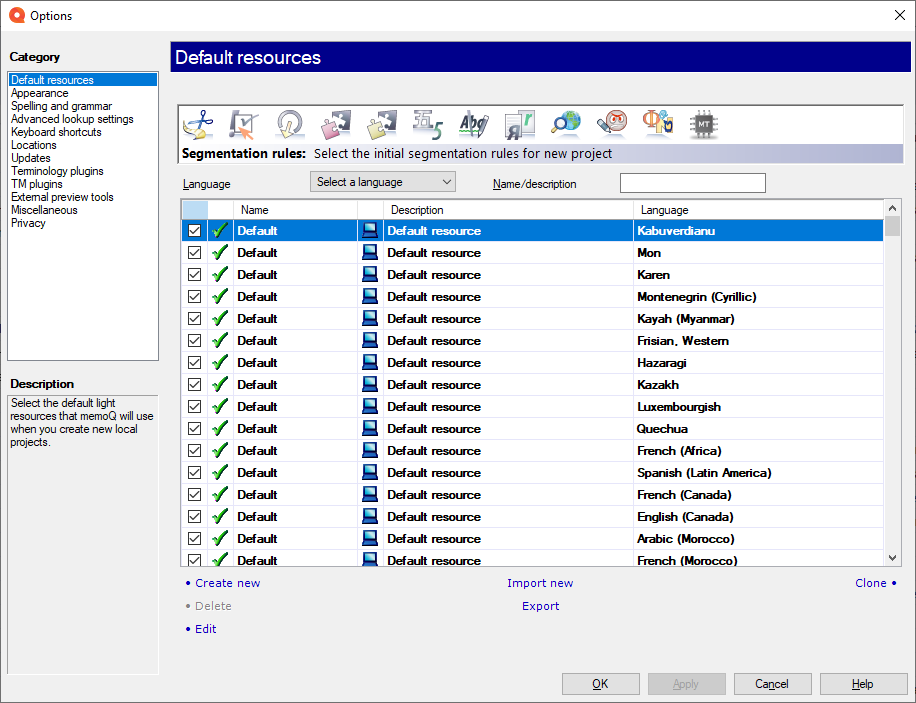Options - Default resources
Under Default resources, you can choose the light resources (segmentation rules, auto-translation rules, QA settings etc.) for all new projects you create in this copy of memoQ.
Do not change default resources here, use templates instead: When you create projects from templates, memoQ will use the resources and settings that are set in the template. Those can be different from the default resources. With templates, you have more control over what goes into a new project.
How to get here
- Open the Options window: At the very top of the memoQ window - in the Quick Access toolbar
 -, click the Options (cogwheels)
-, click the Options (cogwheels)  icon. The Options window opens.
icon. The Options window opens. - Under Category, click Default resources. The Default resources pane appears.

What can you do?
Choose a resource type. memoQ comes with a number of pre-installed local resources:
- Segmentation rules: one each for all supported source languages
- QA settings: one generic set of settings for all languages
- Export path rules
- TM settings
- LiveDocs settings
- Auto-translation rules for some languages
- Ignore lists: no pre-installed ignore list, but you can create one or more
- AutoCorrect lists: no pre-installed AutoCorrect list, but you can create one or more
- Web search: generic sets of settings for the languages you have chosen from the source and target drop-down lists here. Select your web search settings, which you want to use in your projects, here.
- LQA models: pre-installed LQA models, but you can create your own models or more.
Note: LQA models in any other UI language than English need to be published on your memoQ server to make them available in online projects (see this Help Center article about LQA models for different UI languages).
- Font substitution settings: settings to change the font for document export.
- MT settings: Machine translation setting profiles.
To choose a resource type, click the corresponding icon at the top.
For each resource type, you can use the same commands as in the Resource console: you can create new resources, delete or edit existing ones; import new resources from *.mqres (XML) files, export the resources to *.mqres files, and clone (make copies) of them.
It is not recommended to create or import new resources here.
In the list of resources, each resource has a check box. If a check box is checked, that resource will be used in new projects - but not if a project is created from a template and the template has a different setting.
Some resources are language-dependent. For those resources, you must also choose the language. For example, segmentation rules are turned on for all languages, but when you create a project, memoQ will use the segmentation rule set for the source language of the project.
If there are several resources for a category and for the same language, check the check box of a resource to make it default. The check box of the previous default resource will be cleared.
When you finish
To save the settings and return to memoQ: Click OK.
To save the settings and remain in the Options window: Click Apply.
To return to memoQ without making changes: Click Cancel.
- Default resources: Choose default resources (segmentation rules, QA settings, ignore lists etc.) for new projects. Do not mix these with resources in project templates. If you create a project from a template, memoQ will use the settings from the template, and not from these options.
- Appearance: Font and color settings for the translation editor and the Translation results pane. Use this to make the translation editor more readable.
- Spelling and grammar: Open this to set up the spell checker. Choose to use Word or Hunspell. If you choose Hunspell, you can download and install new dictionaries. Set up the spell checker for every target language you work with.
- Advanced lookup settings: Choose how memoQ should offer automatic concordance results, and how it should put together suggestions from fragments (shorter translation memory units and terms). Do not change the defaults unless you are entirely certain that you will get better suggestions as a result. If you just tamper with these settings, you may lose productivity. To learn more about these types of suggestions, see Help about the Translation results pane.
- Keyboard shortcuts: Choose or edit keyboard shortcuts for frequent commands in memoQ. Do not change these before you learn to use memoQ thoroughly. After you change keyboard shortcuts, the Help pages may not help you find them.
- Locations: Check or change the locations of memoQ folders. These are the folders memoQ places local projects and checkouts, translation memories, term bases, and others. You may need to change these if you are running low on disk space on your default drive. Do not change them unless it is absolutely necessary. Do not place them on network drives. If you place these folders in synchronized locations (local copies of Dropbox, Onedrive etc.), memoQ may become slower.
- Updates: Choose how memoQ should check for updates.
- Terminology plugins: Set up external terminology resources. memoQ can connect to various external terminology providers.
- TM plugins: Set up access to external translation memory services.
- External preview tools: Manage preview tools that are not built into memoQ, but installed separately.
- Miscellaneous: Configure various settings that control how memoQ's editing interface works.
- Privacy: Learn about memoQ's privacy policy, and enable or disable anonymous usage data sharing with memoQ's designers and developers.